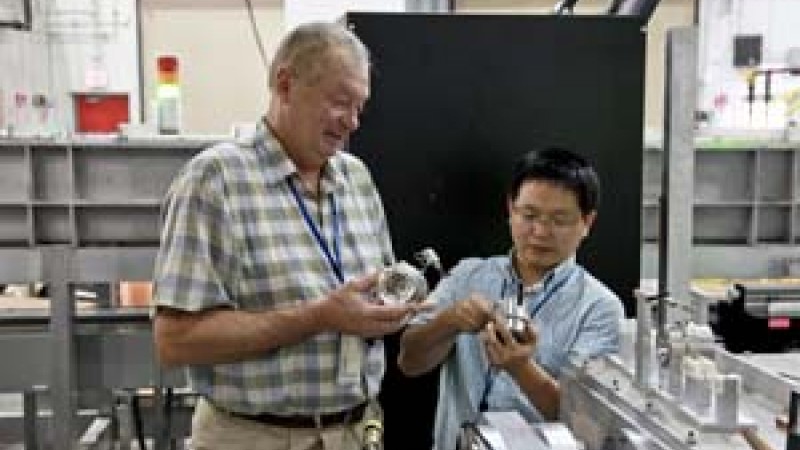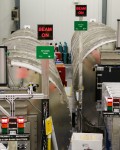Researchers have measured the phase behavior of green house gases in pores at the angstrom level, using small-angle neutron scattering (SANS) at the Oak Ridge National Laboratory’s High Flux Isotope Reactor.
Yuri Melnichenko, an instrument scientist on the General-Purpose Small-Angle Neutron Scattering (GP-SANS) Diffractometer at ORNL’s High Flux Isotope Reactor, his postdoctoral associate Lilin He and collaborators Nidia Gallego and Cristian Contescu from the Material Sciences Division (ORNL) were engaged in the work. They were studying nanoporous carbons to assess their attractiveness as storage media for hydrogen, with a view to potential use for on-board hydrogen storage for transportation applications. Nanoporous carbons can also serve as electrode material for supercapacitors and batteries.
The researchers successfully determined that the most efficiently condensing pore size in a carbon nanoporous material for hydrogen storage is less than one nanometer. In a paper recently published by the Journal of the American Chemical Society, the collaborators used SANS to study how hydrogen condenses in small pores at ambient temperature. They discovered that the surface-molecule interactions create internal pressures in pores that may exceed the external gas pressure by a factor of up to 50. “This is an exciting result,” Melnichenko said, “as you achieve extreme densification in pores ‘for free,’ i.e., without spending any energy. These results can be used to guide the development of new carbon adsorbents tailored to maximize hydrogen storage capacities.”
Another important factor that defines the adsorption capacity of sub-nanometer pores is their shape. In order to get accurate structural information and maximize sorption capacity, it is important that pores are small and of approximately uniform size. In collaboration with Drexel University’s Yury Gogotsi, who supplied the samples, Melnichenko and his collaborators used the GP-SANS instrument to study how the size and shape of pores in sub-nanometer porous carbons varies, depending on the manufacturing conditions. Although small-angle X-ray scattering (SAXS) can do the job too, Melnichenko says, the SANS method broke new ground in analyzing the shape and behavior of pores at subnanometer size when subjected to varying synthesis temperature. “We found that these very small pores are in fact spherical, and that when we change the synthesis conditions, they become elongated, even ‘slit-like,’ and all of this on a subnanometer scale,” Melnichenko said.
"People normally use SANS to study relatively big objects of the order of hundreds of nanometers. But where is the limit at the other end? How small is the object, such that we can still resolve and determine the structural parameters?"
“For SANS, this is achieving a remarkable new limit where we can measure at this very low, subnanometer scale making use of the extended range of scattering angles available at GP-SANS (i.e., angstroms = tenths of billionths of a meter).” The paper describing this study has been published recently in Microporous and Mesoporous Materials (“Small-angle neutron scattering characterization of the structure of nanoporous carbons for energy-related applications”).
Melnichenko and his many collaborators are developing compelling new neutron science strategies trying to supply the geologists with information that may help them to to store environmentally harmful greenhouse gases in coal pores underground and to safely extract methane as a clean energy source from impenetrable shales. These new methods may also help chemists to develop monodisperse, tailored porous media for hydrogen for use in cars, and for supercapacitors and batteries.
The energy and environmentally significant research at ORNL is proceeding on several fronts, in multiple collaborations. In a recent paper published in Fuel and cited as an Editor’s Choice in a recent issue of the prestigious journal Science, the researchers laid out a methodological approach for resolving questions of liquid-liquid and liquid-gas coexistence in coal pores of varying size and fluid accessibility (“The Accessibility of Pores in Coal to Methane and Carbon Dioxide”).
“This is a huge problem. There is a big matrix of a great number of different parameters that may influence the behavior of a fluid in small pores,” said Melnichenko.
The phenomenon of liquid-gas coexistence, called supercriticality, can be readily understood by considering water boiling in a sealed kettle. When you heat water in a regular kettle, you can make tea or coffee. But what happens if the vessel is sealed, as liquids or gases are sealed in underground coal pores? In your kettle ultimately, at a temperature called the liquid-gas critical point, the density of liquid water and water vapor become identical: there is no more water, there is no more gas. What you have is a supercritical fluid.
“When we understood this very specific behavior of bulk fluids near their critical points, we asked how this behavior would change if the whole system was confined in a very small space, such as a small pore in coal or activated carbon,” Melnichenko said.
”Here is a very beautiful, fundamental problem about how confinement in small pores affects the phase behavior of fluids. And we have very good potential applications, such as to sequester unwanted CO2 in coal seams so deep underground, that they are inaccessible to mining. The temperature and pressure down there are so high that CO2 becomes supercritical.”
Another important application of this work is for methane extraction, to find ways to extract methane by displacing it with CO2. On the U.S. east coast, there are literally giga-tonnes of methane that is valuable for energy, trapped in what are called “tight gas shales” ─ impenetrably hard shale beds such as the Marcellus Shale, a massive marine sedimentary rock formation.
To understand more about methane, the researchers looked at model systems of nanoporous carbon aerogels. Chemists tailor aerogels so researchers have several known parameters in their study. “To understand the behavior of supercritical fluids in very complex structural systems like coal or shale, you want to fix as many parameters as you can and vary only one or two,” Melnichenko said. “You want to work with structurally simplified model systems that capture the major features of coal or shale and yet are chemically clean. The work recently appeared in the Journal of Microporous and Mesoporous Materials. (“Effect of carbon dioxide and nitrogen on the diffusivity of methane confined in nano-porous carbon aerogel”).
The researchers proceed by both SANS and quasi-elastic neutron scattering (QENS). SANS is a diffraction method that allows researchers to study the porous structure of coals. “You put your material in the beam, shine neutrons through it and register the scattering pattern,” Melnichenko explained. “You make certain model assumptions, and draw some conclusions about the structure. Then you compare your calculations with what you actually measured. If you see a discrepancy, then your model is not right. Your understanding of the structure is not right. So you do a next iteration, until you understand the structure of your material.”
SANS is elastic scattering, i.e., there is no energy exchange between the neutron and the pore structure. “If you saturate the pores with a fluid under pressure, evidently you will see differences in the scattering pattern,” Melnichenko explained, "between your structure with no fluid and your structure with fluid, at a given temperature and pressure. Then you can make some judgments about what those changes mean; you can interpret them in terms of the phase behavior of the fluid.
“And you can extract very important information, such as the density of confined fluid, the volume fraction of confined fluid in the pores, and also the number of pores that are empty, where no fluid is confined.”
QENS is called inelastic, as there is an energy exchange between the neutrons and the molecules or atoms in a sample. “You put the sample in the neutron beam and monitor the energy exchange, at different scattering angles. Depending on how fast the atoms or molecules move, there will be very specific energy exchange. The neutron’s energy before and after the scattering is quantified and gives data on the mobility of the atoms and molecules in your system.”
QENS gives the researchers a chance to calculate the diffusion coefficient of fluids in pores, the shift in energy from the neutrons to the confined fluid, that allows researchers to make calculations about the molecular mobility of such an underground system.
In recent methane studies published with Suresh Chathoth and Eugene Mamontov in Microporous and Mesoporous Materials, Melnichenko’s group combined SANS and QENS. They used the GP-SANS at HFIR to study pore structure and methane adsorption, and the Backscattering Spectrometer (BASIS) at the Spallation Neutron Source to study fluid dynamics inside the pores. The methane is valuable as energy; the CO2 can take its place in the pores, where it may be permanently stored.
“These are two very different ways of approaching the problem: phase behavior and mobility. In the one, no energy exchange, a completely frozen situation; in the other, a dynamic situation where there is energy exchange. And you can change the temperature and pressure of your fluid inside the pores, and see the mobility change. Then you use your models and make your findings about whether the applications are possible.”
In another approach to their work on the behavior of CO2 confined in nanopores, the researchers recently turned to a silica aerogel model system. Silica aerogel is a good matrix material because it is a chemically clean substance. “There is only silica dioxide on the surface, so you can fix the surface chemistry and vary the concentrations of the silica dioxide; you can vary the surface area and the porosity and see how that influences the phase behavior of the molecules of CO2 or methane.” The paper, with Salvino Ciccariello and Lilin He, was recently accepted by the Journal of Physical Chemistry ("Phase Behavior of Carbon Dioxide Confined in Silica Aerogel in the Vicinity of the Bulk Critical Point”). This paper describes a new methodology for SANS data analysis, entailing how to extract density and volume data from confined fluids in pores of shale and coal. The researchers are continually looking for more accurate methods to provide unique information that can be used in the fields of heterogeneous catalysis and CO2 sequestration in underground geological formations.
On his desk, Melnichenko rests his elbows on a stack of papers, in process of acceptance or in press. “We have great collaborations with several groups of geologists from all around the world. The interest for these studies is high and currently we have more experimental data than we can handle. Looks like this stack won’t get any slimmer in the near future,” he said.
Research at Oak Ridge National Laboratory’s High Flux Isotope Reactor was sponsored by the Laboratory Directed Research and Development Program and the Scientific User Facilities Division, Office of Basic Energy Sciences, U.S. Department of Energy.
Published Work
Yuri B. Melnichenko, Lilin He, Richard Sakurovs, Arkady L. Kholodenko, Tomasz Blach, Maria Mastalerz, Andrzej P. Radlinski, Gang Cheng, and David F. R. Mildner, “Accessibility of pores in coal to methane and carbon dioxide,” Fuel 91, 200-208 (2012); doi: 10.1016/j.fuel.2011.06.026.
Nidia C. Gallego, Lilin He, Dipendu Saha, Cristian I. Contescu, and Yuri B. Melnichenko, “Hydrogen Confinement in Carbon Nanopores: Extreme Densification at Ambient Temperature,” J. Am. Chem. Soc. 133(35), 13794–13797 (2011); doi: 10.1021/ja202432x.
Lilin He, Suresh M. Chathoth, Yuri B. Melnichenko, Volker Presser, John McDonough, and Yury Gogotsi, “Small-angle neutron scattering characterization of the structure of nanoporous carbons for energy-related applications.” Microporous and Mesoporous Materialsi 149(1), 46-54 (2012); doi: 10.1016/j.micromeso.2011.08.035.
S. M. Chathoth, L. He, E. Mamontov, and Y. B. Melnichenko, “Effect of carbon dioxide and nitrogen on the diffusivity of methane confined in nano-porous carbon aerogels,” Microporous and Mesoporous Materials 148, 101-106 (2012); doi:10.1016/j.micromeso.2011.07.019.
Salvino Ciccariello, Yuri B. Melnichenko, and Lilin He, “Phase Behavior of Carbon Dioxide Confined in Silica Aerogel in the Vicinity of the Bulk Critical Point,” J. Phys. Chem. C, (2011); doi: 10.1021/jp205189g.





